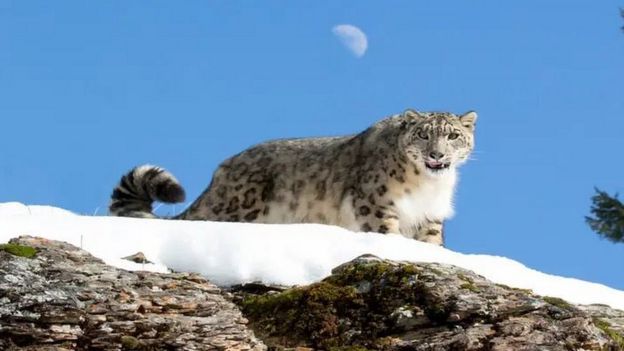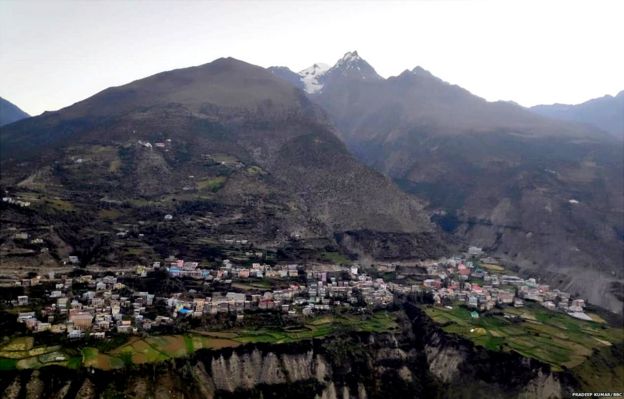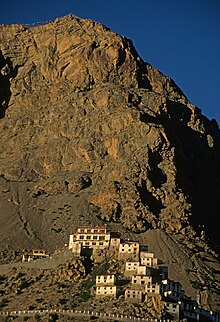राज्य के 12 ज़िलों में से एक लाहौल और स्पीति को दो अलग अलग ज़िलों लाहौल और स्पीति को मिलाकर बनाया गया है. स्पीति किन्नौर से जुड़ा है, जो कि राज्य का एक अन्य आदिवासी ज़िला है, इसकी सीमा तिब्बत के इलाके से लगी हुई है और इसे ठंडा रेगिस्तान भी कहा जाता है.
यहां की कठिन परिस्थितियों की वजह से लाहौल स्पीति का इलाका अव्यवस्थित है. 16 हज़ार फ़ीट की ऊंचाई पर यहां ग्लेशियर या हिम नदियां मौजूद हैं. जलवायु परिवर्तन के कारण आज तक यहां लोग पत्ता गोभी, टमाटर, गाजर, मूली, हरी मटर, आलू जैसी हर तरह की पत्तेदार सब्जियां उगाने में सक्षम हो रहे हैं. वहीं कुछ बागीचे सेब के कारोबार में लगे हैं.
पिन वैली नेशनल पार्क और किब्बर वन्यजीव अभ्यारण्य इस इलाके के ऐसे दो संरक्षित क्षेत्र हैं जहां स्नो लेपर्ड रहते हैं.

कीलॉन्ग - (10,000 फ़ीट की ऊंचाई पर )लाहौल-स्पीति का मुख्यालय है

The Lahaul and Spiti district in the Indian state of Himachal Pradesh consists of the two formerly separate districts of Lahaul and Spiti. The present administrative centre is Keylong in Lahaul. Before the two districts were merged, Kardang was the capital of Lahaul, and Dhankar the capital of Spiti. The district was formed in 1960, and is the fourth least populous district in India (out of 640)

Kunzum la or the Kunzum Pass (altitude 4,551 m (14,931 ft)) is the entrance pass to the Spiti Valley from Lahaul. It is 21 km (13 mi) from Chandra Tal. This district is connected to Manali through the Rohtang Pass. To the south, Spiti ends 24 km (15 mi) from Tabo, at the Sumdo where the road enters Kinnaur and joins with National Highway No. 5 .
The two valleys are quite different in character. Spiti is more barren and difficult to cross, with an average elevation of the valley floor of 4,270 m (14,010 ft). It is enclosed between lofty ranges, with the Spiti river rushing out of a gorge in the southeast to meet the Sutlej River. It is a typical mountain desert area with an average annual rainfall of only 170 mm (6.7 in).
The harsh conditions of Lahaul permit only scattered tufts of hardy grasses and shrubs to grow, even below 4 km (13,000 ft). Glacier lines are usually found at 5 km (16,000 ft). Due to certain changes in climate, nowadays people are being able to grow some vegetables in the Lahaul valley e.g. cabbage, potato, green peas, radish, tomato, carrot and all types of leafy vegetables. The main cash crops are potatoes, cabbage, and green peas.
The valley has snow leopards, foxes ibex, Himalayan brown bear, Musk Deer, and Himalayan blue sheep. There are two important protected areas in the region that are home to snow leopard and its prey including the Pin Valley National Park and Kibber Wildlife Sanctuary. Animals such as yaks and dzos roam across the wild Lingti plains. However, over-hunting and a decrease in food supplies has led to a large decrease in the population of the Tibetan antelope, argali, kiangs, musk deer, and snow leopards in these regions, reducing them to the status of endangered species. Surprisingly, due to ardent religious beliefs, the locals of Spiti do not hunt these wild animals.
Apart from the exotic wildlife, the Valley of Spiti is also known for its wealth of flora and the profusion of wild flowers. Some of the most common species found here include Causinia thomsonii, Seseli trilobum, Crepis flexuosa, Caragana brevifolia and Krascheninikovia ceratoides. Then there are more than 62 species of medicinal plants found here.
According to the 2011 census Lahaul and Spiti district has a population of 31,564. This gives it a ranking of 638th in India (out of a total of 640). The district has a population density of 2 inhabitants per square kilometre (5.2/sq mi). Its population growth rate over the decade 2001-2011 was -5%. Lahul and Spiti has a sex ratio of 903 females for every 1000 males, and a literacy rate of 76.81%.
At the 2011 census, 41% of the population in the district had Kinnauri as their first language, 27% – Pattani, 3.0% – Bhotia, 2.9% – Hindi, 2.8% – Nepali, and 2.6% – Tibetan.
The language, culture, and populations of Lahaul and Spiti are closely related. Generally, the Lahaulis are of Tibetan and Indo-Aryan, while the Spiti Bhot are more similar to the Tibetans, owing to their proximity to Tibet.
| Historical population | ||
|---|---|---|
| Year | Pop. | ±% p.a. |
| 1901 | 12,392 | — |
| 1911 | 12,981 | +0.47% |
| 1921 | 12,836 | −0.11% |
| 1931 | 13,733 | +0.68% |
| 1941 | 14,594 | +0.61% |
| 1951 | 15,338 | +0.50% |
| 1961 | 23,682 | +4.44% |
| 1971 | 27,568 | +1.53% |
| 1981 | 32,100 | +1.53% |
| 1991 | 31,294 | −0.25% |
| 2001 | 33,224 | +0.60% |
| 2011 | 31,564 | −0.51% |
Tourism
One of the most interesting places is the Tabo Monastery, located 45 km from Kaza, Himachal Pradesh, the capital of the Spiti region. This monastery rose to prominence when it celebrated its thousandth year of existence in 1996. It houses a collection of Buddhist scriptures, Buddhist statues and Thangkas. The ancient gompa is finished with mud plaster, and contains several scriptures and documents. Lama Dzangpo heads the gompa here. There is a modern guest house with a dining hall and all facilities are available.
Another gompa, Kardang Monastery, is located at an elevation of 3,500 metres across the river, about 8 km from Keylong. Kardang is well connected by the road via the Tandi bridge which is about 14 km from Keylong. Built in the 12th century, this monastery houses a large library of Buddhist literature including the main Kangyur and Tangyur scriptures.
The treacherous weather in Lahaul and Spiti permits visitors to tour only between the months of June to October, when the roads and villages are free of snow and the high passes (Rothang La and Kunzum La) are open. It is possible to access Spiti from Kinnaur (along the Sutlej) all through the year, although the road is sometimes temporarily closed by landslides or avalanches.
